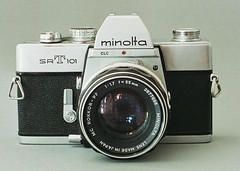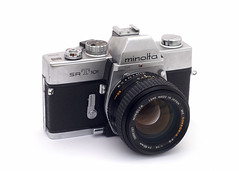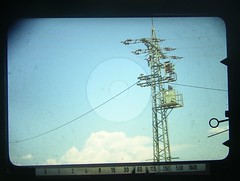The camera
The Minolta SR-T 101 is a 35mm SLR camera made by Minolta Camera Co. Ltd, Japan. It was launched in 1966 and stayed with only minor changes in production for ten years, proving the thorough development effort being put into the camera before introduced. The body is a direct continuation of the Minolta SR-7 model V of 1962, itself an innovative camera. However, the SR-T has many significant features apart from the TTL meter. Perhaps the most notable one being the full aperture metering facility, which automatically compensates for the speed of the lens fitted on the camera at any time, a feature it took Nikon twelve more years to figure out how to accomplish. Full aperture metering in 35mm SLR cameras was pioneered by the brilliant Tokyo Kogaku Topcon RE-Super, a feature lacking in every screw mount camera until Olympus Kogaku introduced the Olympus FTL, their first full frame 35mm SLR in 1971, which was abandoned one year later in favour of the OM system.
When introduced, the shutter speed dial barrel on the SR-T was black, the film take-up spool black, and the focusing ring on the lens was not scalloped, just plain with shallow segmented grooves. The camera body serial numbers started at 1000xxx, and the splendid MC Rokkor 1:1.4 f=58mm lens at 5xxxxxx. A very well crafted ever-ready case was available in either brown or black leather to protect the camera with normal lens.
The SR-T has an extremely bright finder with a central micro prism focusing aid that proves to be very accurate in most cases, since even when no visible lines are present in the subject, all out-of-focus objects appear to shimmer. The exposure meter needle and the selected shutter speed are visible in the viewfinder. A small rectangle to the right indicates the correct needle deflection for a healthy battery when a switch on the camera base is set to BC ("battery check"). Battery power is saved by placing the switch in the OFF position whenever the camera is not used. The metering circuit is dependent on an obsolete mercury battery. It may be replaced using a zinc-air hearing aid 1.4 volt battery, which usually comes in a six-pack and is not very expensive.
Several internal parts may fail on a forty-year-old camera, and the SR-T 101 is no exception. The only serious trouble is related to the exposure meter movement itself, in which the tiny coil tends to break, this situation requires a replacement. The back door rubber sealing foam will usually need replacement, and so will a small strip of same cushioning the mirror when it goes up. A strip of this may be cut from a similar sealing material from a hardware store. All other problems are easily put right with a minimum of effort and tools, unless the camera is worn out, which rarely happens. In fact, anybody who figures out how to remove the top cover without causing any damage may repair it oneself.
How old is my Minolta SR-T 101?
During the ten-year manufacturing period of the Minolta SR-T101, many small changes were made to the camera body. Several of these changes are easily detected and they can help determine time of manufacture to within a few years. It should be noted that any part of a camera may be replaced due to repair and smaller parts are more easily swapped, but normally these features may be considered original. Top cover and base plate are parts usually replaced due to impact damages, and a replacement top cover would not have the original serial number.
1966-late 1969: the first generation 101’s have a finely-knurled black shutter speed barrel (even on chromed body models), and have single slot screws holding the base plate and top cover on, while later generations use Phillips head screws. From 1966 into 1967, the two screws at the back of the top cover were the same distance from the eyepiece, while on all later SR-T‘s the right-hand screw is farther away from the eyepiece. From 1968 on, the black plastic shoulder pieces between the front cover and the top cover are held in place by visible screws.
1970-1973: the second generation and later 101’s have a coarse ridged chromed shutter speed barrel. From 1972 on, as seen on the inside of the top cover, the film counter clear plastic window is glued in place, while on earlier versions it is held in place by an internal bracket.
1973-1975: on the third generation 101’s, the black plastic piece under the accessory shoe protrudes up in front of the shoe, forming a ridge, while earlier versions have a single metal peg instead.
The lack of mirror lockup (MLU) on an SR-T101 is not an exact indicator of its age. MLU first began to be discontinued early in the transition to the second generation, but did continue at least until the third generation SR-T.
Metering: CLC and full aperture TTL
Camera ads from the 1970s boast of its CLC (Contrast Light Metering), calling it "the brain". CLC is a form of TTL metering with two CdS cells. It compensates for over-exposure by assuming that the upper side of the picture is the sky (overcast) and that the lower part is the subject you want to photograph. ISO values can be set from 6 to 6400.
| viewfinder |
|---|
|
The SR-T 101's viewfinder shows the exposure meter's needle at the right side of the finder image. The circle on the second visible needle shows the light value needed for the actual shutter-speed/aperture selection. When these pre-selections are corrected manually this 2nd needle moves towards the meter's needle. The second image shows the meter in battery control mode: needle over the little rectangle means correct voltage. |
Correct exposure is achieved by matching a needle in the viewfinder to a circle moving with the exposure settings. Strangely though, the needle moves down when light increases.
The Minolta SR-T 101 was one of the first cameras to have full aperture TTL metering. This was possible thanks to the fact that Minolta had placed the aperture ring on its Rokkor MC lenses close to the camera body. This way, the position of the aperture ring could be communicated mechanically to the metering system inside the camera. What is actually transmitted is not the aperture itself, but the offset between the selected aperture and the lens' maximal aperture.
Other specifications
- The SR-T 101 has a cloth focal plane shutter with speeds from 1 sec to 1/1000. The film advance lever automatically cocks the shutter, preventing double exposures. Shutter speeds are shown at the bottom of the viewfinder.
- It has some interesting features which set it apart from many other SLRs of that time, like mirror lockup, a mechanical self-timer and a depth-of-field preview button.
- The manual-focus Rokkor lenses have a very good reputation and some are very fast: the fastest standard lens in SR-T101 time was 58mm f/1.2 MC Rokkor PG.
- The SR-T 101 uses a PX625 cell for the metering system only. With a dead battery, all functions but the meter will continue to work.
Links
- Minolta SR-T series; an overview of features.
- Review at Classic Cameras
- Rokkor files
- SR-T 101 Manual (JPEG Scans)
- SR-T 101 versions and comparison with contemporary SLRs
- SRT-101, SRT-101 noir, SRT-101b on www.collection-appareils.fr by Sylvain Halgand
- French User manual, Service manual on www.collection-appareils.fr by Sylvain Halgand
Photobloggers Using the SR-T 101
| Minolta Classic Cameras |
|---|
| Vest (or Best) | V2 | SR-2 | SRT 101 | XE | XD | CLE | 7000 | 9000 | 800 si |



